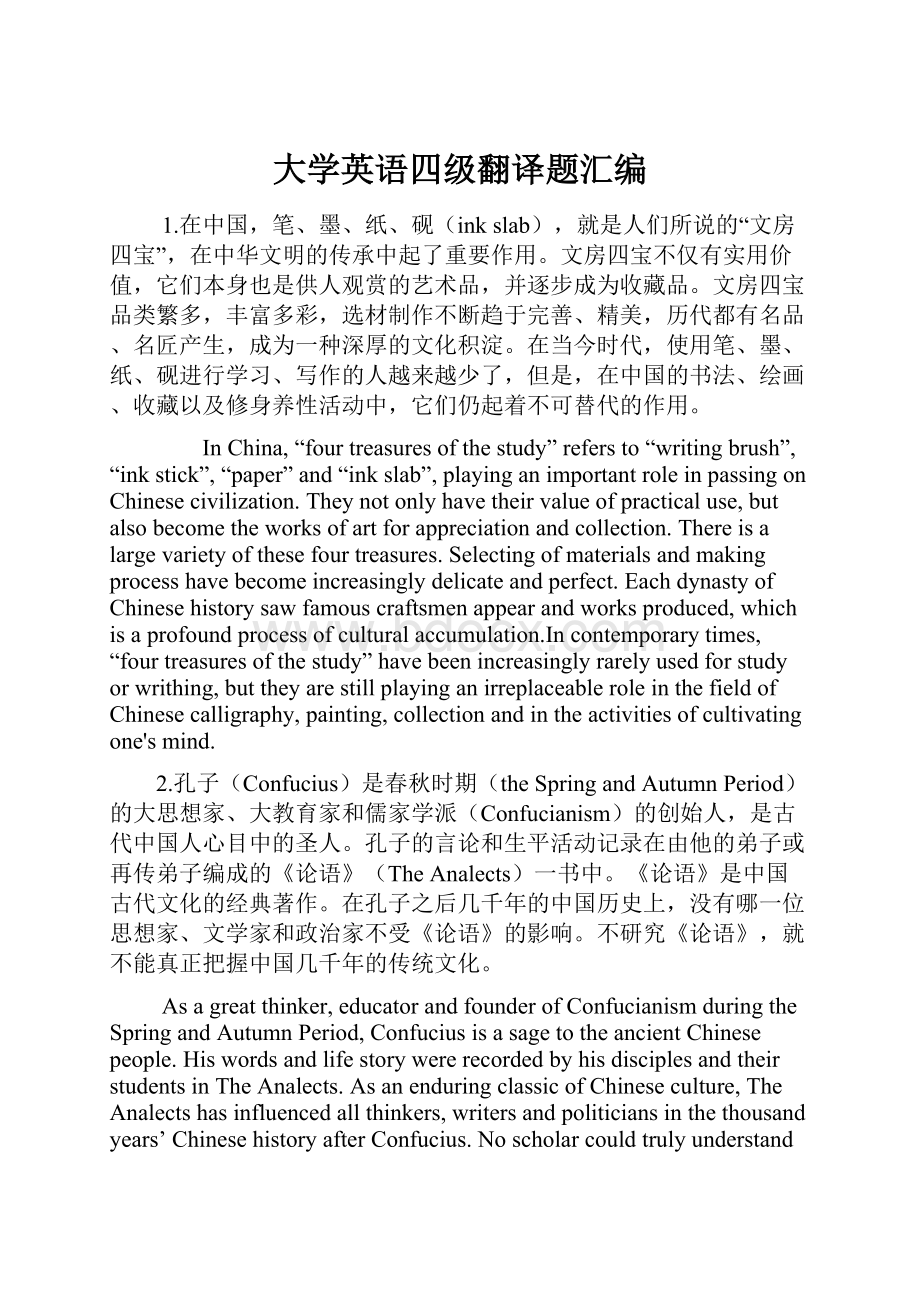大学英语四级翻译题汇编.docx
《大学英语四级翻译题汇编.docx》由会员分享,可在线阅读,更多相关《大学英语四级翻译题汇编.docx(20页珍藏版)》请在冰豆网上搜索。

大学英语四级翻译题汇编
1.在中国,笔、墨、纸、砚(inkslab),就是人们所说的“文房四宝”,在中华文明的传承中起了重要作用。
文房四宝不仅有实用价值,它们本身也是供人观赏的艺术品,并逐步成为收藏品。
文房四宝品类繁多,丰富多彩,选材制作不断趋于完善、精美,历代都有名品、名匠产生,成为一种深厚的文化积淀。
在当今时代,使用笔、墨、纸、砚进行学习、写作的人越来越少了,但是,在中国的书法、绘画、收藏以及修身养性活动中,它们仍起着不可替代的作用。
InChina,“fourtreasuresofthestudy”refersto“writingbrush”,“inkstick”,“paper”and“inkslab”,playinganimportantroleinpassingonChinesecivilization.Theynotonlyhavetheirvalueofpracticaluse,butalsobecometheworksofartforappreciationandcollection.Thereisalargevarietyofthesefourtreasures.Selectingofmaterialsandmakingprocesshavebecomeincreasinglydelicateandperfect.EachdynastyofChinesehistorysawfamouscraftsmenappearandworksproduced,whichisaprofoundprocessofculturalaccumulation.Incontemporarytimes,“fourtreasuresofthestudy”havebeenincreasinglyrarelyusedforstudyorwrithing,buttheyarestillplayinganirreplaceableroleinthefieldofChinesecalligraphy,painting,collectionandintheactivitiesofcultivatingone'smind.
2.孔子(Confucius)是春秋时期(theSpringandAutumnPeriod)的大思想家、大教育家和儒家学派(Confucianism)的创始人,是古代中国人心目中的圣人。
孔子的言论和生平活动记录在由他的弟子或再传弟子编成的《论语》(TheAnalects)一书中。
《论语》是中国古代文化的经典著作。
在孔子之后几千年的中国历史上,没有哪一位思想家、文学家和政治家不受《论语》的影响。
不研究《论语》,就不能真正把握中国几千年的传统文化。
Asagreatthinker,educatorandfounderofConfucianismduringtheSpringandAutumnPeriod,ConfuciusisasagetotheancientChinesepeople.HiswordsandlifestorywererecordedbyhisdisciplesandtheirstudentsinTheAnalects.AsanenduringclassicofChineseculture,TheAnalectshasinfluencedallthinkers,writersandpoliticiansinthethousandyears’ChinesehistoryafterConfucius.Noscholarcouldtrulyunderstandthislong-standingcultureortheinnerworldoftheancientChinesewithoutthisbook.
3.大约在两千多年前,中国就出现了蜡染(waxprinting)。
在中国服饰中,蜡染是一种流传时间长、流行范围大、使用领域广的服装工艺。
蜡染是在布匹着色的过程中,以蜂蜡(beeswax)作为防止染色的材料。
蜂蜡干了之后,会产生一些裂纹,这些裂纹在染色过程中渗透进靛蓝色,于是形成了如冰花式样的美妙纹理。
这样自然天成的纹理可以说是蜡染的灵魂所在。
WaxprintingappearedinChinaabout2,000yearsago.WaxprintinghaslongbeenawidespreadtechniqueusedinthehistoryofChinesefashion.Duringthedyeingprocess,beeswaxisappliedtopreventsomepartsoftheclothformbeingdyed.Whenthebeeswaxdries,itdevelopscracks,whichabsorbindigointheprocessofdyeing,thusformingthebeautifulnaturallinesresemblingbreakingice.Thesenaturallyformedlinesrepresentthebeautyandsoulofwaxprinting.
4.景泰蓝(cloisonné)是驰名中外的传统工艺,它集青铜艺术、瓷器和雕刻诸种工艺制作技巧于一身,是一门地道的北京绝活。
它是收藏家收藏的佳品,也是人们居家使用的精美物品。
这项工艺始创于明代景泰年间,初创时的颜色主要是蓝色,故得名“景泰蓝”。
到了成化年间,景泰蓝技术进一步成熟,这个时期的作品沉稳凝重又透明灵动,而且铜胎也极为讲究。
CloisonnéisatraditionalartwidelyknowninandoutsideChina.ItisakindofsuperblocalexpertiseformofBeijing,whichcombinestheskillsofbronzeart,porcelain,carvingandothertypesoffolkarts.Itisdeemedvaluableintheeyesofcollectors,aswellasrefinedornamentsfordailyuse.ThemakingofcloisonnéfirstappearedduringtheJingtaireignoftheMingDynasty,withthemaincolourusedbeingblue,hencethename“JingtaiBlue”asitbecameknownlateron.BythetimeoftheChenghuareign,thetechniquesformakingcloisonnéwerefurtherdeveloped,withproductsofthisperiodlookingheavyanddignifiedyetnotlackingineloquenceorvividness.Moreover,itscastwasalwaysmadeofchoicecopper.
5.饺子是深受中国人民喜爱的传统食品。
相传为古代医圣张仲景发明。
饺子的制作是包括:
1)擀皮、2)备馅、3)包馅水煮三个步骤。
其特点是皮薄馅嫩,味道鲜美,形状独特,百食不厌。
民间有“好吃不过饺子”的俗语。
中国人接亲待客、逢年过节都有包饺子吃的习俗,寓意吉利。
对崇尚亲情的中国人来说,“更岁交子”吃饺子,更是欢度除夕、辞旧迎新必不可少的内容。
DumplingsareoneoftheChinesepeople’sfavoritetraditionaldishes.AccordingtoanancientChineselegend,dumplingswerefirstmadebythemedicalsaint---ZhangZhongjing.Therearethreestepsinvolvedinmakingdumplings:
1)makedumplingwrappersoutofdumplingflour;2)preparethedumplingstuffing;3)makedumplingsandboilthem.Withthinandelasticdoughskin,freshandtenderstuffing,delicioustaste,anduniqueshapes,dumplingsarewortheatinghundredsoftimes.There’sanoldsayingthatclaims,“Nothingcouldbemoredeliciousthandumplings”.DuringtheSpringFestivalandotherholidays,orwhentreatingrelativesandfriends,Chinesepeopleliketofollowtheauspiciouscustomofeatingdumplings.ToChinesepeoplewhoshowhighreverenceforfamilylove,havingdumplingsatthemomenttheoldyearisreplacedbythenewisanessentialpartofbiddingfarewelltotheoldandusheringinthenewyear.
6.汉字是从原始人用以记事的简单图画,经过不断演变发展最终成为一种兼具音、形、意韵的独特文字。
现存中国古代最早成熟的文字是甲骨文,被认为是现代汉字的初形。
此后,汉字又经历了金文、隶书、楷书、草书、行书等不同的阶段。
汉字结构“外圆内方“,源于古人”天圆地方“的观念。
汉字有五种基本笔画,即:
横、竖、撇、捺、折。
Chinesecharacterswereinitiallymeanttobesimplepicturesusedtohelppeoplerememberthings.Afteralongperiodofdevelopment,itfinallybecameauniquecharactersystemthatembodiesphoneticsound,image,idea,andrhymeatthesametime.Thewritingsystem,whichwasextremelyadvancedinancienttimes,beganwithinscriptionsonbonesandtortoiseshells,andtheseareregardedastheoriginalformsofChinesecharacters.Afterwards,Chinesecharacterswentthroughnumerouscalligraphicstyles:
bronzeinscriptions,officialscript,regularscript,cursivescript,runningscript,etc.Chinesecharactersareusuallyroundoutsideandsquareinside,whichisrootedinancientChinesebeliefsofanorbicularskyandarectangularEarth.ThefivebasicstrokesofChinesecharactersare“---“(thehorizontalstroke)“│”(theverticalstroke),“/”(theleft-fallingstroke),“\”(theright-fallingstroke),and“乙”(theturningstroke).
7.中国的青铜器时代(BronzeAge)从夏开始,经历商、西周到春秋时期(theSpringandAutumnPeriod),前后持续了一千五百多年的时间。
大量出土的青铜器物表明,中国创造了灿烂的青铜文明。
这些青铜器物不仅有丰富的政治和宗教内涵,而且还具有很高的艺术价值。
今藏于中国历史博物馆的大盂鼎(theGreatDingforYu)是中国青铜器时代的代表性作品之一。
它是西周康王(KingKang)时期的作品,距今大约有三千多年。
TheBronzeAgeinChinalastedmorethan1,500years,fromtheXiathroughtheShangandWesternZhouDynasties,totheSpringandAutumnPeriod.Largenumbersofunearthedartifactsindicateahighlevelofancientbronzecivilizationinthecountry.Theyfeaturerichpoliticalandreligiousthemes,andareofhighartisticvalue.ArepresentativeexampleistheGreatDingforYu,whichisnowpreservedintheMuseumofChineseHistory.Itwascastabout3,000yearsagoduringthereignofKingKangofWesternZhouDynasty.
8.1911年,中国爆发了历史上的第一次资产阶级革命——辛亥革命(theRevolutionof1911),它推翻了中国封建社会的最后一个朝代——清朝,废除了中国延续了2000多年的封建帝制,建立了中国的第一个民主共和国——中华民国。
民国政府成立以后,要求全国人民都剪掉头上的辫子(queues),选择自己喜欢的发型。
至此,在中国延续了280多年的辫子法令终于被解除。
In1911,thefirstbourgeoisrevolutioninChinesehistory—theRevolutionof1911brokeout.ThelastdynastyoftheChinesefeudalsociety,QingDynasty,wasover-thrownandthemonarchsystemthathadahistoryofmorethan2,000yearswasabolished.TheRepublicofChina,thefirstdemocraticrepublicinChina,wasfoundedin1912.Afteritsfoundation,thegovernmentofRepublicofChinahadrequiredthecitizenstocutofftheirqueuesandmakethehaircuttheyliked.Sincethen,thewearing-queueorderthathadlastedformorethan280yearsinChinahasbeenabolished.
9.端午节,又叫龙舟节,是为了纪念爱国诗人屈原。
屈原是一位忠诚和受人敬仰的大臣(minister),他给国家带来了和平和繁荣。
但最后因为受到诽谤(vilify)而最终投河自尽。
人们撑船到他自尽的地方,抛下粽子,希望鱼儿吃粽子,不要吃屈原的身躯。
几千年来,端午节的特色在于吃粽子(glutinousdumplings)和赛龙舟,尤其是在一些河湖密布的南方省份。
TheDuanwuFestival,alsocalledtheDragonBoatFestival,istocommemoratethepatrioticpoetQuYuan.QuYuanwasaloyalandhighlyesteemedminister,whobroughtpeaceandprosperitytothestatebutendedupdrowninghimselfinariverasaresultofbeingvilified.Peoplegottothespotbyboatandcastglutinousdumplingsintothewater,hopingthatthefishesatethedumplingsinsteadofQuYuan’sbody.Forthousandsofyears,thefestivalhasbeenmarkedbyglutinousdumplingsanddragonboatraces,especiallyinthesouthernprovinceswheretherearemanyriversandlakes.
10.京剧被誉为“东方歌剧”,是地道的中国国粹。
它起源于中国多种古老的地方戏剧,特别是南方的“徽班”。
到了19世纪末,京剧形成并成为中国最大的戏曲剧种。
京剧是综合性表演艺术,集唱(歌唱)、念(念白)、做(表演)、打(武)、舞(舞蹈)为一体,通过程式化的表演手段,叙述故事,刻画人物。
角色主要分生(男性)、旦(女性)、净(男性)、丑(男性女性皆有)四大行当。
ChineseBeijingOperaPraisedas“OrientalOpera”,BeijingOperaisagenuinenationalquintessenceofChina.Itoriginatedfrommanykindsofancientlocaloperas,especiallyhuibaninsouthernChina.Attheendofthe19thCentury,BeijingOperaevolvedandtookshape,becomingthegreatestkindofoperainChina.BeijingOperaisablendofperformingarts---song,speech,performance,acrobatixfightinganddance.BeijingOperaportraysandnarratestheplotandcharactersthroughstylizedacting.ThemaintypesofrolesinBeijingOperaaresheng(male),dan(youngfemale),jing(paintedface,male),andchou(clown,maleorfemale).
11.北京烤鸭是自封建帝王时代就在北京城流行的著名菜肴,如今它被认为是中国的一道国菜。
这道菜以它薄而脆的酥皮,以及厨师们在客人面前片鸭子的真实情形而著称。
专门用于制作烤鸭的鸭子在养殖65天后就被屠宰了,鸭子在烤制前要先用调料腌制(season),然后才送进焖炉或者挂炉。
鸭肉通常配上葱(scallion)、黄瓜和甜面酱,用薄饼卷着食用。
PekingduckisafamousduckdishthathasbeenpopularsincetheimperialerainBeijing,andisnowconsideredanationaldishofChina.Thedishisprizedforthethin,crispskinwithauthenticvisionofthedishservingslicedinfrontofthedinersbythecook.Ducksbredspeciallyforthedishareslaughteredafter65daysandseasonedbeforebeingroastedinaclosedorhungoven.Themeatisusuallyeatenwithpancakes,scallion,cucumbersandsweetbeansauce.
12.在中国,喝茶是一种仪式(ritual),一种精致品味(refinedtaste)的展示。
人们在饮茶的同时,也领略着(takedelightin)品茶的情趣之意。
喝茶聊天是中国人中最流行的打发时间的方式。
过去,他们是以进有名的茶馆(teahouse)而开始一天的生活的。
中国的茶馆相当于法国的咖啡馆和英国的酒馆。
到这里不仅是为了喝茶,也是为了议论当地的新闻或就政治话题进行激烈的(furious)争论。
TeadrinkinginChinaisaritualandademonstrationoftherefinedtaste.Whiledrinkingtea,peoplealsotakedelightintheessenceOfteaitself.ChattingoverapotofteaisaverypopularwayOfpastimeamongChinese.Inthepast,theywouldstartthedaywithavisittoawell—knownteahouse.ChineseteahouseswouldbetheequivalentofFrenchcafesandEnglishpubs.Peoplecomeherenotjust